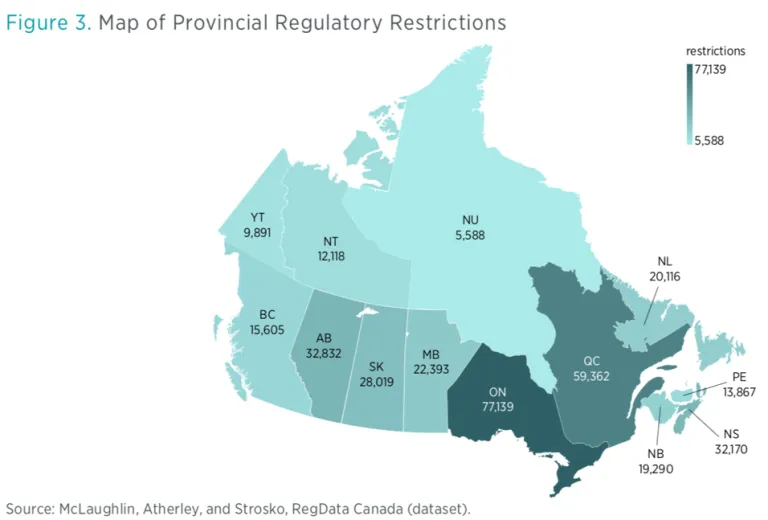- | Expert Commentary Expert Commentary
- |
New Research on US, Canadian Regulation, and Housing Affordability
Research Round-Up: March 25, 2019
State Regulatory Snapshots for Oklahoma, New Hampshire, and South Carolina
James Broughel | State Snapshots
James Broughel released three state snapshots this week, analyzing the regulatory burdens for Oklahoma, New Hampshire, and South Carolina. As he says in the introduction for each: "It would take an ordinary person more than two and a half years to read the entire US Code of Federal Regulations (CFR), which contained nearly 104 million words in 2017. The sheer size of the CFR poses a problem not just for the individuals and businesses that want to stay in compliance with the law but also for anyone interested in understanding the consequences of this massive system of rules. States also have sizable regulatory codes, which add an additional layer to the large body of federal regulation.”
Efficiency Analysis Would Aid Regulatory Policymaking in South Carolina
James Broughel | State Testimony
From the testimony: "There is a long bipartisan history of support for cost-benefit analysis for federal regulations in Washington, DC. For example, Gerald Ford was the first president to issue an executive order requiring economic analysis for major federal regulations. Since then, presidents of both parties, including Presidents Carter, Reagan, Clinton, and Obama have reaffirmed the importance of subjecting regulations to the scrutiny of economic analysis. Most US states are much further behind in this regard, but legislation like House Bill 3113 that is currently before this subcommittee would advance the use of evidence-based policy in South Carolina, making South Carolina a model for other states.”
Arizona Occupational Licensing: Barriers to Opportunity in the Grand Canyon State
Matthew D. Mitchell | State Testimony
From the testimony: "Licensing reduces employment opportunities, especially among certain communities. High barriers to employment pose particular difficulties to lower-skilled, lower-educated populations, to immigrants, to those with criminal records, and to those who move frequently, such as military spouses. Eighty percent of the studies Mercatus scholars reviewed found that licensure has a disparate impact on minorities. Recent research suggests that barriers to entry are associated with greater income inequality and that licensure is negatively associated with absolute income mobility.”
RegData Canada: A Data-Driven Approach to Regulatory Reform
Patrick McLaughlin | Policy Brief
From the brief: "RegData Canada, a data project from the Mercatus Center at George Mason University that was launched in 2018, allows regulators and policymakers to better identify and prioritize regulations that may need reform. The RegData Canada project involves applying customized text-analysis software and machine learning algorithms to regulatory text issued by federal and provincial regulators, resulting in 14 unique datasets: a Canadian federal dataset and 13 provincial datasets. All of these datasets are freely available online at QuantGov.org.”

RegData Canada: A Snapshot of Regulatory Restrictions in Canada’s Provinces
Patrick McLaughlin, Stephen Strosko, and Laura Jones | Policy Brief
From the brief: "While this is first time data on regulatory restrictions for the Canadian federal government and for the Canadian provinces are available, there have been other regulatory counts done by Canadian governments. For example, British Columbia (BC) has been tracking “regulatory requirements” since 2001, when a baseline of 330,812 was established. BC’s definition of regulatory requirements is similar to RegData’s definition of regulatory restrictions but broader as it includes obligations found in legislation and guidance documents in addition to those found in regulations. RegData Canada, conversely, only tallies prohibitions and obligations found in regulatory text alone—therefore, restrictions in legislation and regulatory guidance documents are not included. BC’s regulatory requirements count is currently 166,919, according to the BC government’s latest report. Figure 1 shows BC’s regulatory restriction count, from RegData Canada, at 15,605.”
The Danger in Using Monetary Policy to Address Housing Affordability
Kevin Erdmann | Policy Brief
From the brief: "This means that a collapse in prices was not inevitable. But more importantly, this means that calls for tighter monetary policy during the boom were calamitous. Loose monetary policy has been widely blamed for high home prices and for the debt-fueled consumption that they funded. Critics, and even Federal Reserve policymakers, generally agree that monetary policy should have been tightened sooner. But this is the wrong conclusion. In fact, monetary policy was powerless to counteract the debt-fueled consumption of the boom period, and the bust was only inevitable because the Fed tried to solve a problem that it could not functionally solve with tighter monetary policy.”